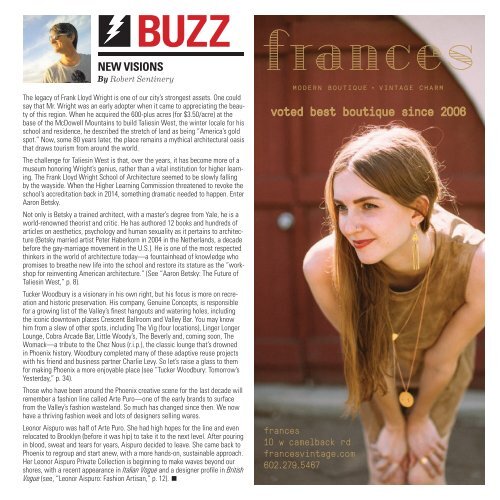Java.Mar.2016
Create successful ePaper yourself
Turn your PDF publications into a flip-book with our unique Google optimized e-Paper software.
NEW VISIONS<br />
By Robert Sentinery<br />
BUZZ<br />
The legacy of Frank Lloyd Wright is one of our city’s strongest assets. One could<br />
say that Mr. Wright was an early adopter when it came to appreciating the beauty<br />
of this region. When he acquired the 600-plus acres (for $3.50/acre) at the<br />
base of the McDowell Mountains to build Taliesin West, the winter locale for his<br />
school and residence, he described the stretch of land as being “America’s gold<br />
spot.” Now, some 80 years later, the place remains a mythical architectural oasis<br />
that draws tourism from around the world.<br />
The challenge for Taliesin West is that, over the years, it has become more of a<br />
museum honoring Wright’s genius, rather than a vital institution for higher learning.<br />
The Frank Lloyd Wright School of Architecture seemed to be slowly falling<br />
by the wayside. When the Higher Learning Commission threatened to revoke the<br />
school’s accreditation back in 2014, something dramatic needed to happen. Enter<br />
Aaron Betsky.<br />
Not only is Betsky a trained architect, with a master’s degree from Yale, he is a<br />
world-renowned theorist and critic. He has authored 12 books and hundreds of<br />
articles on aesthetics, psychology and human sexuality as it pertains to architecture<br />
(Betsky married artist Peter Haberkorn in 2004 in the Netherlands, a decade<br />
before the gay-marriage movement in the U.S.). He is one of the most respected<br />
thinkers in the world of architecture today—a fountainhead of knowledge who<br />
promises to breathe new life into the school and restore its stature as the “workshop<br />
for reinventing American architecture.” (See “Aaron Betsky: The Future of<br />
Taliesin West,” p. 8).<br />
Tucker Woodbury is a visionary in his own right, but his focus is more on recreation<br />
and historic preservation. His company, Genuine Concepts, is responsible<br />
for a growing list of the Valley’s finest hangouts and watering holes, including<br />
the iconic downtown places Crescent Ballroom and Valley Bar. You may know<br />
him from a slew of other spots, including The Vig (four locations), Linger Longer<br />
Lounge, Cobra Arcade Bar, Little Woody’s, The Beverly and, coming soon, The<br />
Womack—a tribute to the Chez Nous (r.i.p.), the classic lounge that’s drowned<br />
in Phoenix history. Woodbury completed many of these adaptive reuse projects<br />
with his friend and business partner Charlie Levy. So let’s raise a glass to them<br />
for making Phoenix a more enjoyable place (see “Tucker Woodbury: Tomorrow’s<br />
Yesterday,” p. 34).<br />
Those who have been around the Phoenix creative scene for the last decade will<br />
remember a fashion line called Arte Puro—one of the early brands to surface<br />
from the Valley’s fashion wasteland. So much has changed since then. We now<br />
have a thriving fashion week and lots of designers selling wares.<br />
Leonor Aispuro was half of Arte Puro. She had high hopes for the line and even<br />
relocated to Brooklyn (before it was hip) to take it to the next level. After pouring<br />
in blood, sweat and tears for years, Aispuro decided to leave. She came back to<br />
Phoenix to regroup and start anew, with a more hands-on, sustainable approach.<br />
Her Leonor Aispuro Private Collection is beginning to make waves beyond our<br />
shores, with a recent appearance in Italian Vogue and a designer profile in British<br />
Vogue (see, “Leonor Aispuro: Fashion Artisan,” p. 12).


















